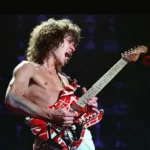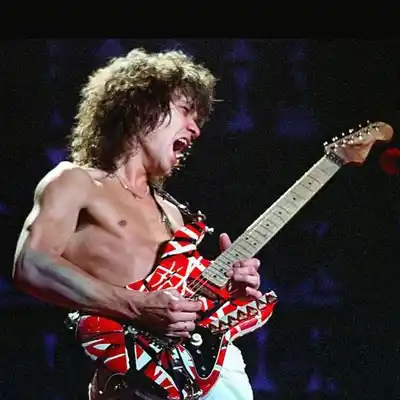
Eddie Van Halen – The Finger-tapping Maestro
Let’s talk about Eddie Van Halen.
Who was this man, and why do so many see him as one of the greatest guitarists to have ever lived?
Table of Contents
Early Life
Edward Lodewijk Van Halen was born in Amsterdam, in 1955. Eddie and his family moved to Pasadena, California in the 1960s. It’s hard to believe, but Eddie first started on drums while his brother Alex tinkered with the guitar. Soon enough, their roles reversed, and the world got one of its most iconic guitarists, while Alex became a powerhouse on drums.
Van Halen
In the mid-70s, the brothers formed the band ‘Van Halen’ with David Lee Roth (vocals) and Michael Anthony (bass).
With Eddie’s innovative guitar work and Roth’s dynamic stage presence, they were soon signed and released their self-titled debut album in 1978.
Songs like “Runnin’ with the Devil” and the instrumental “Eruption” showcased Eddie’s skills and changed the way many looked at the electric guitar.
The Diamond Dave Era
With David Lee Roth, Van Halen wasn’t just about the music. Their onstage antics, the wild parties, and of course, the unmistakable chemistry between Eddie’s guitar prowess and Roth’s charismatic vocals made them one of the biggest acts of the late ’70s and early ’80s.
Albums like “1984” with hits such as “Jump” and “Panama” became anthems of a generation.
But like many rock and roll tales, internal tensions led to Roth departing the band in 1985. Fans were devastated.
The question on everyone’s lips: What’s next for Van Halen?
Hagar Era
The band didn’t waste much time mourning. The new vocalist was Sammy Hagar. With Hagar, Van Halen’s sound evolved. They became more melodic, producing hits like “Why Can’t This Be Love” and “Right Now.”
The Hagar era, sometimes referred to as “Van Hagar,” had its own charm and set of fans. However, not all original fans were on board with the band’s changing sound, leading to some division among the Van Halen faithful.
Throughout the Roth and Hagar eras, one thing remained constant: Eddie’s growth as a musician. He started to play keyboards, producing iconic intros like in “Jump.” His guitar sound matured, becoming more refined while retaining that raw edge.
Guitar Technique
Eddie was not just a fast player; he was a game-changer. He popularized the technique of finger-tapping, using both hands on the guitar neck to create rapid arpeggios. This wasn’t just about speed; it was about creating sounds that no one had heard before.
Guitar
Not satisfied with the sounds he got from commercial guitars, he built his own!
The “Frankenstrat,” a combination of Fender Stratocaster and Gibson parts, became his iconic instrument. With its unique striped design, it wasn’t just the sound that caught attention; it was a visual statement too.
Not Just a Rocker
While rock and metal were his mainstays, Eddie’s playing transcended genres. Remember Michael Jackson’s “Beat It”? That fiery guitar solo was performed by none other than Eddie.
Personal Battles
Like many rock stars, Eddie had his battles. Substance abuse and health issues, including cancer, took a toll on him. But through it all, his passion for music remained undiminished. In interviews, he often spoke about the therapeutic power of playing his guitar.
Legacy
Eddie Van Halen left us in 2020, but his influence remains undeniable. Guitarists from all genres cite him as an inspiration. His finger-tapping technique was popularized to such an extent that it’s hard to imagine a modern rock guitar without it.
His knack for creating memorable riffs and pushing the boundaries of what was possible on the guitar cemented his place in music history.
